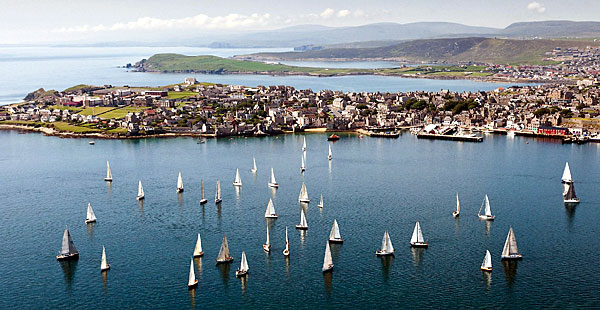
Scapa Flow with the island of Hoy beyond
MORAY FIRTH
This large triangle of water lying between Rattray Head and Duncansby Head is exposed to the north and east, sheltered from the south and west, and in summer usually enjoys dry and sunny weather. You can either sail from place to place, or if on passage to the Northern Isles or Scandinavia can use strategic ports like Wick and Peterhead, which have excellent marina facilities, as departure points.
The Firth has developed substantially over the past decade, and now offers very good boating harbour facilities all around its shores, including at Banff, Whitehills, Lossiemouth, Findhorn, Inverness, Cromarty, Helmsdale and Wick.
The Caledonian Canal is a major asset, linking the east and west coasts, and providing marina and boatyard facilities at the Inverness end. This famous short cut avoids the potentially challenging voyage around the north of Scotland, and is an interesting and enjoyable passage through some spectacular mountains and lochs.
A major attraction when cruising the Moray Firth is the abundant sea-life. The Firth’s large porpoise and dolphin population seems to enjoy meeting and greeting boats.
ORKNEY
The Orkney group consists of the principal island of Mainland, and some 13 other inhabited islands extending some 40 miles from north to south, and 30 miles east to west. At its nearest point it is just 5 miles from the Scottish mainland, but that stretch of water is The Pentland Firth, noted for its fierce tides which must be treated with respect. Indeed, the whole archipelago is subject to the full force of the tidal stream in and out of the North Sea, creating a regime not dissimilar to that of the Channel Islands, although with a much smaller tidal range.
The islands to visit include Hoy, South Ronaldsay, Sanday, and Stronsay, as well as Mainland Orkney itself.
Most inter-island passages will be achieved in a few hours, but as the tides are the commanding factor in passage planning in these parts, onward progress is often limited to a 5 or 6 hour window of tidal opportunity.
Visits to archaeological sites at Maes Howe, Skara Brae, and the towns of Kirkwall and Stromness are a must when visiting the Orkney Isles.
SHETLAND
Shetland offers a remote and totally unspoiled cruising ground, with its 100 small islands and 900 miles of coastline, and offers a beautiful combination of dramatic cliffs and natural harbours. Piers and small marinas nestle in sheltered and scenic inlets, and the coastal landscape forms a varying backdrop.
Your yacht allows you easy access to the smaller islands, and nowhere on the land is more than three miles from the coast. Interesting walks, great fishing in fresh water lochs, and five millennia of history can be enjoyed at over 6,000 archaeological sites.
Shetland is also one of Europe’s unique wilderness environments. Birds, seals, otters, dolphins and whales are everywhere – the whole island group is a naturalist’s paradise! Much of the coast is steep-to, with deep water close to shore, fantastic water clarity and hazards well-charted.
Marinas and piers form the heart of the islands’ small communities, and there are many small marinas around the coast. The main calling ports are Lerwick, Symbister, Baltasound, and Scalloway.
Fair Isle is located halfway between Orkney and Shetland, and with a good harbour is a favourite stopover on that passage.
Shetland’s location also makes it a useful staging post during longer passages, whether heading south to the UK, east to Norway, north to Faeroe, or perhaps even further afield.
The Shetland Islands may lie at 60°N, but they enjoy a warm climate for their latitude, thanks to the temperate waters of the Atlantic.

Lerwick Harbour regularly hosts sailing events, and is a favourite port of call for long distance races

